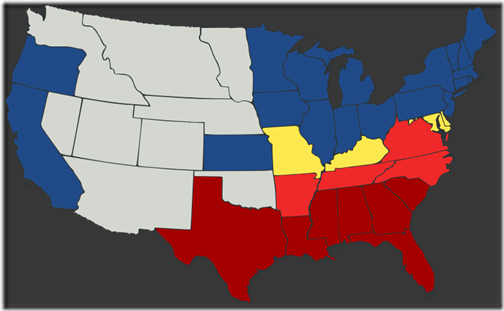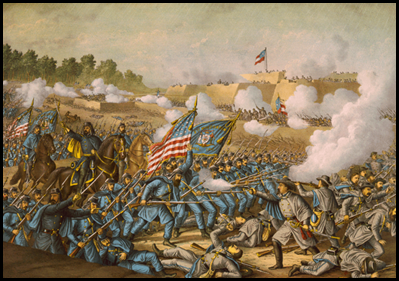Potted Civil War

|
Pepe’s Potted Civil
War Now I’ll be the first to admit, I knew
zero about the American Civil War other than it has made for great reenactments,
but as to who was who, and why they fought about it - no clue. Wandering round
Wal-Mart, with this in mind, Bear bought me the film Gettysburg as he thought
watching it may put me right. Steady. Well,
how any of the actors made it out of the make-up department beggars belief. They
had enormous pieces (in various shades) of shag pile super glued to their tops
lips, it was quite off putting. Jeff Daniels actually had Dougal from the Magic
Roundabout stuck on his top lip.
Going back to reenactments reminds me of some smashing lines in Bear’s
chick flick – Sweet Home Alabama. Reece Witherspoon playing Melanie Carmichael
has to go up on to the battle field to find her dad Earl Smooter. She calls
“Daddy”, “Daddy”. One of the dead sticks his head up and says" “Who you lookin’
for Darlin’ “. “Earl Smooter”. Someone else says “5th Regiment” another says
“About to surrender”. Then they all lay down dead again.
Ok so I have to put in some more quotes.
Candice Bergen
plays Mayor Kate Hennings and one of her lines is “There’s nothing wrong with
poor people, I get elected by poor people”. Going off course for a minute who
can forget Candice Bergen, Shirley Schmidt in Boston Legal who demanded to meet
Denny Crane’s blow up doll – Shirley Schmidt Ho, that looked spookily like her.
As she and the doll come face to face she asks Denny if he doesn’t find this a
bit degrading. Denny’s response “Are you jealous”.
Back to Sweet Home Alabama said with deep
southern accents. The character Bobby Ray “You can take the girl out of Honky
Tonk, but you can’t take the Honky Tonk out of the girl”.
Earl Smooter “Even if he’s a Yankee, at
least he’s sober”
Melanie Carmichael “Well you must be
Jake’s hot date. I’m Melanie, Jake’s snotty Yankee bitch wife who he refuses to
divorce”.
But the best and my favourite has to be
from Earl Smooter “You can’t ride two horses with one ass,
Sugarbean”.
Right. Well. Moving smoothly on. Back to the
war.
Some of the notable Commanders and Leaders: US – Abraham Lincoln, Winfield Scott, George B McClellan, Henry Wager Halleck, Ulysses S Grant and Gideon Welles. They had 2,100,100 soldiers. Killed in action 140,414. Total dead 365,000. 275,200 wounded. Confederates – Jefferson Davis, PGT Beauregard, Joseph E Johnston, Robert E Lee and Stephen Mallory. They had 1,064,000 soldiers. Killed in action 72,524. Total dead 260,000 wounded 137,000.
The bloodiest battle of the war was Battle of Gettysburg in Pennsylvania from the 1st to the 3rd of July 1863. The Confederate Commander was Robert E. Lee with 75,000 soldiers, lost 28,063. The Union Commander and victor was George G. Meade with 82,289 soldiers, lost 23,049.
The American Civil War
(1861–1865):
In response to the election of Abraham Lincoln as President of the United
States, eleven
southern slave states
declared their secession from the U.S. and formed the Confederate States of
America ("the
Confederacy"); the other twenty five states supported the federal government
("the Union"). After
four years of warfare, mostly within the Southern states, the Confederacy
surrendered and slavery was outlawed everywhere in the nation. Issues that led
to war were partially resolved in the Reconstruction Era that followed, though others
remained unresolved.
 US
map of 1861, show affiliation of states and territories regarding the Secession
War (Civil War.)
Legend:
States that seceded before the 15th of April
1861
States that seceded after the 15th of April
1861
Territories,
unaffiliated
In the presidential election of 1860, the Republican Party, led by Abraham Lincoln, had campaigned against expanding slavery beyond the states in which it already existed. The Republicans strongly advocated nationalism, and in their 1860 platform they denounced threats of disunion as avowals of treason. After a Republican victory, but before the new administration took office on the 4th of March, seven cotton states declared their sucession and joined to form the Confederate States of America. Both the outgoing administration of President James Buchanan and the incoming administration rejected the legality of secession, considering it rebellion. The other eight slave states rejected calls for secession at this point. No country in the world recognized the Confederacy. Hostilities began on the 12th of April 1861, when Confederate forces attacked a U.S. military installation at Fort Sumter in South Carolina. Lincoln responded by calling for a volunteer army from each state to recapture federal property, which led to declarations of secession by four more slave states. Both sides raised armies as the Union seized control of the border states early in the war and established a naval blockade. Land warfare in the East was inconclusive in 1861–62, as the Confederacy beat back Union efforts to capture its capital, Richmond, Virginia, notably during the Peninsular Campaign. (What is striking to Bear is that Richmond, the Confederate capitol was only eighty miles from Washington D.C. the Union capitol). In September 1862, the confederate campaign in Maryland ended in defeat at the Battle of Antietam, which dissuaded the British from intervening. Days after that battle, Lincoln issued the Emancipation Proclamation, which made ending slavery a war goal.
In 1863, confederate general Robert E. Lee’s northward advance ended in defeat at the Battle of Gettysburg. To the west, the Union gained control of the Mississippi River after the Battle of Shiloh and Siege of Vicksburg, splitting the Confederacy in two and destroying much of their western army. Due to his western successes, Ulysses S. Grant was given command of the eastern army in 1864, and organised the armies of William Tecumseh Sherman, Philip Sheridan and others to attack the Confederacy from all directions, increasing the North's advantage in manpower. Grant restructured the union army, and put other generals in command of divisions of the army that were to support his push into Virginia. He led the Overland Campaign to seize Richmond, though in the face of fierce resistance he altered his plans and led the Siege of Petersburg which nearly finished off the rest of Lee's army. Meanwhile, Sherman captured Atlanta and marched to the sea, destroying Confederate infrastructure along the way. When the Confederate attempt to defend Petersburg failed, the Confederate army retreated but was pursued and defeated, which resulted in Lee's surrender to Grant at Appomattox Court House on the 9th of April 1865.
The American Civil War was one of the earliest true industrial wars. Railroads, the telegraph, steamships and mass-produced weapons were employed extensively. The practices of total war, developed by Sherman in Georgia and of trench warfare around Petersburg foreshadowed World War I in Europe. It remains the deadliest war in American history, resulting in the deaths of six hundred and twenty thousands soldiers and an undetermined number of civilian casualties. Historian John Huddleston estimates the death toll at ten percent of all Northern males aged twenty to forty five years old, and thirty percent of all Southern white males aged eighteen to forty. Victory for the North meant the end of the Confederacy and of slavery in the United States and strengthened the role of the federal government. The social, political, economic and racial issues of the war decisively shaped the reconstruction era that lasted to 1877.
The second bloodiest battle was the Battle of Chickamauga in Georgia on the 19th and 20th of September 1863. The Confederate Commander and victor was Braxton Bragg with 66,326 soldiers, lost 18,454. The Union Commander was William Rosecrans with 58,222 soldiers, lost 16,170.
At massive cost an end to slavery must be considered a victory
ALL IN ALL I STILL WON’T BE GOING ON MASTERMIND WITH THIS AS A SPECIALIST SUBJECT I’M JUST GLAD I WASN’T THERE WITH YOUR COLOUR VISION SO I AM
|
